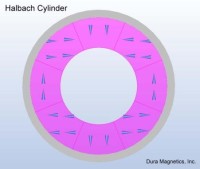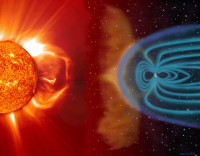There is a lot of information about “Halbach Arrays” available on the Internet, yet much of it is reposted copy with fragmented explanations. This first article in what will become a four-part series about Halbach Arrays will attempt to cohesively demystify the Halbach Array, explain how it works, and cover the advantages and disadvantages of using them.
History and Development of Halbach Arrays
The individual credited with the implementation of the magnet arrangement called a Halbach Array was Dr. Klaus Halbach. Dr. Halbach used these arrays for charge particle beam applications at Berkeley Lab’s famed Advanced Light Source facility (ALS).
How a Halbach Array Works
A moving charged particle will feel a net force exerted on it in the presence of a magnetic field, and so magnetic fields can be used to manipulate moving charged particles. This effect is quite apparent and easy to illustrate.
For example:
The Earth’s magnetic field protects us by “pushing” the high-energy ions, (Solar Winds) emitted by the sun, around and to the poles of the Earth allowing them to bypass life on Earth.
Practical Functions of Halbach Arrays
A magnetic field’s shape and intensity is very important to accelerator applications as a means to perform various experiments. Of its many functions, properly developed magnetic fields can:
- Constrain plasma
- Steer, sort, and accelerate moving charged particles
- Impart oscillations
Materials Used in Halbach Arrays
Theoretical Materials
Electromagnets can create a magnetic field, but they are large and require sophisticated power supplies and cooling. Permanent magnets are much more desirable, but until high coercivity (Hc & HcJ) and high Residual Induction (Br) permanent magnets were commercialized, designers had to use large Aluminum Nickel Cobalt (Alnico) magnets. The Alnico magnets were simpler to integrate than electromagnets, but they could not be used in an array, as they would demagnetize. This “demagnetization” limited the design and performance of permanent magnets, and therefore, their use.
Practical Materials
 When the new high coercivity magnet alloys were commercialized, designers could start arranging them in arrays where the individual elements would “repel”, and thereby enhance, the magnetic field intensity and shape. These new high coercivity alloys were made from Rare Earth elements. The first was Samarium Cobalt (SmCo), and the second was Neodymium Iron Boron (NdFeB).
When the new high coercivity magnet alloys were commercialized, designers could start arranging them in arrays where the individual elements would “repel”, and thereby enhance, the magnetic field intensity and shape. These new high coercivity alloys were made from Rare Earth elements. The first was Samarium Cobalt (SmCo), and the second was Neodymium Iron Boron (NdFeB).
A classical Halbach Array used for Accelerator Experiments is circular in nature. The volume of interest is in the Inside Diameter (ID). This would be similar to what a powered solenoid (Electromagnet) would create, but without the extra size, cost, and maintenance. These arrangements are called Halbach Cylinders.
Now that you know the practical applications of Halbach Arrays and materials used in their creation, you have a basis for understanding how exactly the two orientations of the Halbach Array produces a magnetic field.
The upcoming post in this four-part series dedicated to explaining Halbach Arrays will cover both how the Halbach Array works, as well as the most common magnetic geometries used in a Halbach Array.


